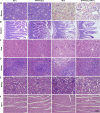Mitochondrial Targeted Cerium Oxide Nanoclusters for Radiation Protection and Promoting Hematopoiesis
- PMID: 38946882
- PMCID: PMC11214556
- DOI: 10.2147/IJN.S459607
Mitochondrial Targeted Cerium Oxide Nanoclusters for Radiation Protection and Promoting Hematopoiesis
Abstract
Purpose: Mitochondrial oxidative stress is an important factor in cell apoptosis. Cerium oxide nanomaterials show great potential for scavenging free radicals and simulating superoxide dismutase (SOD) and catalase (CAT) activities. To solve the problem of poor targeting of cerium oxide nanomaterials, we designed albumin-cerium oxide nanoclusters (TPP-PCNLs) that target the modification of mitochondria with triphenyl phosphate (TPP). TPP-PCNLs are expected to simulate the activity of superoxide dismutase, continuously remove reactive oxygen species, and play a lasting role in radiation protection.
Methods: First, cerium dioxide nanoclusters (CNLs), polyethylene glycol cerium dioxide nanoclusters (PCNLs), and TPP-PCNLs were characterized in terms of their morphology and size, ultraviolet spectrum, dispersion stability and cellular uptake, and colocalization Subsequently, the anti-radiation effects of TPP-PCNLs were investigated using in vitro and in vivo experiments including cell viability, apoptosis, comet assays, histopathology, and dose reduction factor (DRF).
Results: TPP-PCNLs exhibited good stability and biocompatibility. In vitro experiments indicated that TPP-PCNLs could not only target mitochondria excellently but also regulate reactive oxygen species (ROS)levels in whole cells. More importantly, TPP-PCNLs improved the integrity and functionality of mitochondria in irradiated L-02 cells, thereby indirectly eliminating the continuous damage to nuclear DNA caused by mitochondrial oxidative stress. TPP-PCNLs are mainly targeted to the liver, spleen, and other extramedullary hematopoietic organs with a radiation dose reduction factor of 1.30. In vivo experiments showed that TPP-PCNLs effectively improved the survival rate, weight change, hematopoietic function of irradiated animals. Western blot experiments have confirmed that TPP-PCNLs play a role in radiation protection by regulating the mitochondrial apoptotic pathway.
Conclusion: TPP-PCNLs play a radiologically protective role by targeting extramedullary hematopoietic organ-liver cells and mitochondria to continuously clear ROS.
Keywords: ceria nanoclusters; mitochondria targeting; oxidative stress; radioprotective effect; superoxide dismutase.
© 2024 Yang et al.
Conflict of interest statement
The authors report no conflicts of interest in this work.
Figures








References
MeSH terms
Substances
LinkOut - more resources
Full Text Sources
Miscellaneous

